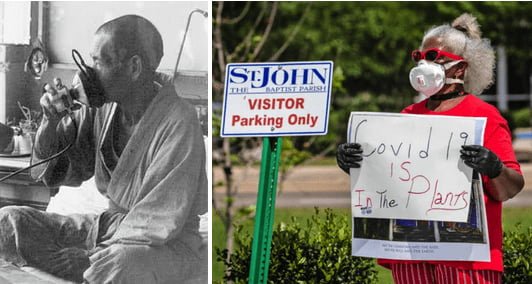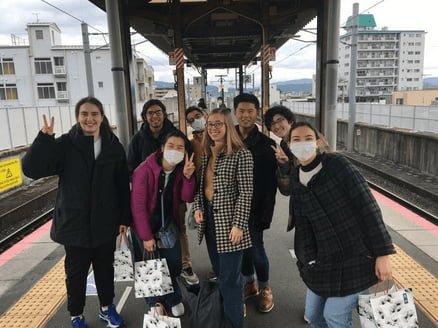From Japan Focus
Abstract: The Coronavirus hit Japan during our study-abroad semester in Kyoto. Here we present similarities in Japanese societal response to chemical pollutants throughout the long twentieth century and to COVID-19, as they became apparent to us through a chemistry course on Japanese industrial pollution.
Key Words: Study abroad, chemistry, COVID-19, Minamata Disease, Yokkaichi Asthma, dioxins, Fukushima nuclear disaster, pollution
Not even a month into our spring 2020 study-abroad semester in Kyoto we noticed a shift in the news cycle. Sitting down to NHK (Nippon Hoso Kyokai) news during dinner with our host families, we saw the media focusing more and more on what seemed – at the time – a looming but somewhat vague threat: COVID-19. One of us was a visiting faculty fellow teaching a chemistry class on Japanese pollution disasters; two of us participated as students in the class. As the semester progressed, we noticed similarities between the developing issue of COVID-19, both in Japan and the US, and our class’s historical case studies: cadmium poisoning (Itai-itai Disease1) caused by mining in Toyama starting in the early 1900s, methylmercury poisoning (Minamata Disease2) caused by a plastics factory in Kumamoto (1932-68), air pollution from petrochemical factories that resulted in respiratory illness (Yokkaichi Asthma3) in the early 1960s, toxic dioxin emissions from waste incinerators in Tokorozawa in the 1990s,4 and radiation from the 2011 nuclear disaster in Fukushima.
 Exhale. Study-abroad students in Japan experienced an unsettling fear as coronavirus became a reality. We watched the pandemic develop through the lens of a course on Japanese industrial pollution. Illustration by R. Ort. |
The virus’ spread meant that we had to leave Kyoto in mid-March and continue our course online in the US, but it also presented a unique opportunity to address our course themes in real time with current events. Our final class discussion was to outline these parallels, which we present here.
1. Vulnerable populations. In early February, our class topic was the chemistry behind Yokkaichi Asthma and air pollution. As we discussed sulfur dioxide and particulate matter (PM), pollutants that led to breathing difficulties in the petrochemical town, a student asked whether poor air quality in China was exacerbating coronavirus-related deaths. When she heard how those dying from the virus tended to have pre-existing conditions, this student aptly made a connection to a class theme. For every chemical pollutant encountered in our course, we examined how certain segments of society were disproportionately vulnerable. The victims of Itai-itai disease were mainly women, often postmenopausal women who had borne children, because cadmium poisoning targeted their already calcium-deficient bones. Methylmercury took a large toll on developing fetuses, making stillbirths and congenital problems some of the hallmarks of Minamata Disease. Along similar lines, this student wondered whether respiratory problems reminiscent of the industrially-induced asthma in Yokkaichi made certain patients more vulnerable to COVID-19. Her comment was prescient. Later in the semester, an academic study linked long-term exposure to PM air pollution to worse COVID-19 health outcomes.5 Having experienced some of the highest air pollution ever, with PM levels in 2013 over 30 times international health standards,6 many in China could indeed have been more susceptible to coronavirus. Poor air quality could be a factor in Japan,7 too, for those who experienced urban pollution from the 1970s onwards and those near coal-fired power plants, a major source of PM. Another academic study described how PM activates the same kind of receptor molecules that the virus uses to attach, suggesting that air pollution itself may also increase COVID-19 infection rates.8 It followed that in the US, those disproportionately susceptible due to higher PM exposure would be low-income minorities, as they are more likely to live near industrial facilities and highways, both sources of PM pollution,9 10, adding to their vulnerabilities.
 Yokkaichi Asthma victim (left) and a protester from St. John the Baptist Parish, Louisiana, USA (right). St. John the Baptist Parish is part of Cancer Alley, a stretch of land between New Orleans and Baton Rouge covered with refineries, petrochemical plants, and factories. Residents, who are predominantly African American, are concerned that toxic pollution from the plants is increasing the community’s vulnerability to COVID-19. Photos from Ito, K. (2018), “Yokkaichi Asthma: The worst air pollution ever in Japan,” Urban Planning and Environmental News Blog, 8 April (Accessed 7 October 2020) and Dermansky, J. (2020), “Long exposed to polluted air, Louisiana’s Cancer Alley residents are now in a COVID-19 Hotspot,” Desmog, 13 April (Accessed 7 October 2020). |
As the virus’ spread grew in the US, it didn’t take us long to see that just like pollution, this virus disproportionately hit the poorest and most marginalized not only in terms of COVID infection rates and health outcomes but also economically. In Minamata, poor fishermen families not only lost their health to methylmercury, but also their livelihood when the government banned the sale of their fish. By the end of the semester, we discussed the emerging parallel in the US; those disproportionately dying of COVID-19 were the same groups who were losing their livelihoods due to the pandemic, low-wage workers, mostly minorities.11 12, After the 2011 nuclear disaster in Fukushima, those most exposed to radiation included poorly paid contract employees whose job it was to clean up the contamination.13 We remarked on the US parallel of essential workers, those who could not afford to stop working, even as their poorly-paid jobs put them at risk. Watching the pressures on US essential-worker families, including those of our own classmates, we wondered about working mothers in Japan. Indeed, Japanese women have been more likely to lose their jobs during the economic recession14 and to take on additional child-rearing responsibilities when schools were closed.15 The pressures have been hardest on Japanese single working mothers,16 a group that already faces ostracism and often works hard to hide their status.17 We also worried about the Japanese homeless population.18 While Japan’s racial and economic disparities are not as prevalent as in the US, we kept looking for news about the coronavirus’ effect on Burakumin and foreign workers in Japan. Our class had left us with a recognition that solutions to COVID-19 will need to address inequalities — whether economic, racial, ethnic or cultural — that make some segments of society more vulnerable. Reassuringly, a variety of work has been calling attention to the experiences of vulnerable populations in Japan during the pandemic.19 20
 Students in our class on our way to the Liberty Human Rights Museum in Osaka. Photo by S. Hsieh. |
2. Stigma and discrimination. A second parallel emerged in the course of our field trip to the Osaka Liberty Human Rights Museum to see their exhibits on Minamata Disease. While class discussions about societal discrimination against Minamata Disease victims were fresh in our minds, we saw discrimination growing alongside the spread of the coronavirus. Students brought up COVID-related discrimination in and outside of class. Some vented about comments they heard around them, disturbed by apparent anti-Chinese sentiment.21 Others shared their discomfort watching the news on Japanese TV, for example when a segment showed an unruly group of Chinese at an airport, followed by interviews with Japanese citizens who voiced what they found displeasing about Chinese tourists. As a class, we reflected on what discrimination would do to the virus’s spread. The stigma associated with Minamata Disease caused some to hide ill family members out of fear of being ostracized. To avoid being stigmatized, would people with COVID-19 symptoms hide their coughs with medications instead of getting tested? If they did, stigma could result in worsening infection rates. Discrimination discouraged us, too, because of its negative impact on mental health and the role it played in delaying solutions. When Minamata victims hid their afflictions, it was harder for society to recognize the pollution problem and push the government to address it. Even after the semester ended, we continued to share news stories that documented COVID-19 discrimination. We were struck in particular by the contrast in treatment of healthcare workers. While applauded in the US for their sacrifice and dedication, doctors and nurses became targets of discrimination in Japan, some even barred from dropping off their children at daycare centers.22 The Japanese pollution cases taught us how discriminatory actions widen divisions within communities at a time when cooperation and mutual support are essential. Yet the same tendency to blame victims that stigmatized those from Minamata and Fukushima23 has continued to grow in Japan24 in the form of korona sabetsu.25
3. Conflicts between economic growth and human health. Even before the economic effects of the pandemic were felt, with millions of jobs lost due to lockdowns and stay-at-home orders, our class felt a tension between preserving economic stability and fighting the virus. In late February, from our perspectives, life in Japan seemed to continue without significant changes or restrictions despite the threat that COVID-19 posed. We kept taking public transportation to classes and went out to restaurants. Japan’s response was different from that of many other Asian countries at the time. Taiwan’s quick response included building capacity for labs to test 2,500 a day as early as mid-February.26 From mid-February to March, while South Korea had ramped up to 15,000 coronavirus tests per day,27 Japan had only conducted 37,726 tests in total.28 Skeptics wondered if the Japanese government was purposefully keeping the coronavirus positive count low in a bid to avoid cancelling the 2020 Tokyo Olympics and to keep foreign tourists coming to spend money in Japan.29 Was the Japanese government once again prioritizing the national economy at the expense of human health, as it did during the period30 of industrial growth in Japan before the 1970s? In Minamata, the Japanese government had long sided with the polluting company, negotiating payments to methylmercury-poisoning victims with clauses that avoided any admission of factory responsibility. In Yokkaichi, the local government planned the construction of more petrochemical factories, even as industrially-caused asthma was so devastating that some patients committed suicide. We were also reminded that it was not just the government that was to blame; societal attitudes often echoed the prioritization of economy. As Minamata fishermen and their families sought compensation for the problems caused by factory effluents, some residents blamed the victims, accusing them of harming the town by making trouble for the polluting company and giving the area a bad reputation. Towards the end of our semester, as lockdowns and debates about reopening the economy began in the US and elsewhere, it became all too obvious that fighting COVID-19 held the same tension between economic growth and human health31 that pollution problems had in Japan as was exemplified throughout our course.
By mid-March, a handful of our students chose to leave Kyoto voluntarily due to the virus. Within a week, the remaining students on our study-abroad program were asked to make plans to return to their home countries, which included not only the US but also Thailand, Mexico and China. Many were reluctant to leave, as they felt that they would have been safer in Kyoto than at their destinations. As the pandemic has continued, and Japan has indeed managed to keep cases lower compared to the disastrous spread in countries including the US, England and Brazil, we have continued to view the crisis through the lens of Japanese pollution disasters. The parallels that emerged while we were in Japan have only grown stronger in the US. We can only hope that the tools that eventually mitigated Japanese pollution cases, from science and technology to citizen and legal action, can also rise to this viral challenge and the societal responses it has brought with it.
Acknowledgements
We thank all of the students in our study-abroad chemistry course: Sarah Ducharme, Abdel Elsayed, Plearn Janvantanavit, Mauricio Martinez, Kanon Shambora, and Brandon Tran. We also thank those who provided critical comments to improve our essay, including Marnie Anderson, Brenna Campbell, George Dutton, Nien-hê Hsieh, Marlene Mayo, and Timothy Webster.
Leave a Reply
You must be logged in to post a comment.